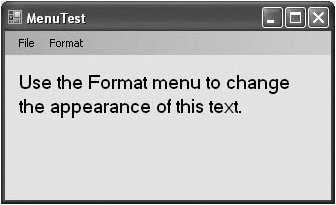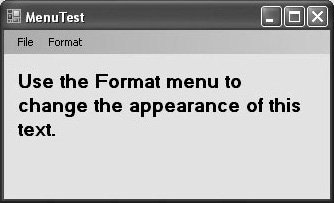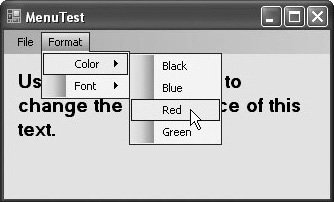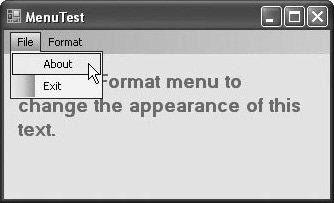Menus
Menus provide groups of related commands for Windows applications. Although these commands depend on the program, somesuch as Open and Saveare common to many applications. Menus are an integral part of GUIs, because they organize commands without "cluttering" the GUI.
In Fig. 14.1, an expanded menu from Visual Studio lists various commands (called menu items), plus submenus (menus within a menu). Notice that the top-level menus appear in the left portion of the figure, whereas any submenus or menu items are displayed to the right. The menu that contains a menu item is called that menu item's parent menu. A menu item that contains a submenu is considered to be the parent of that submenu.
Figure 14.1. Menus, submenus and menu items.
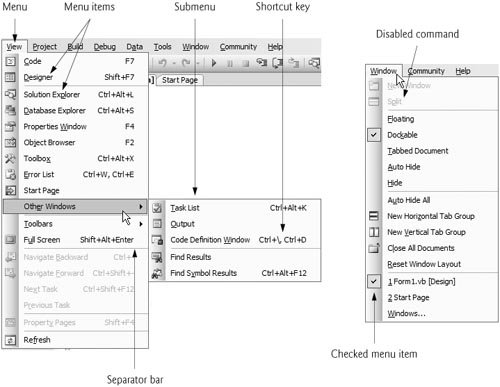
All menu items can have Alt key shortcuts (also called access shortcuts or hotkeys), which are accessed by pressing Alt and the underlined letter (for example, Alt F typically expands the File menu). Menus that are not top-level menus can have shortcut keys as well (combinations of Ctrl, Shift, Alt, F1, F2, letter keys, etc.). Some menu items display check marks, usually indicating that multiple options on the menu can be selected at once.
To create a menu, open the Toolbox and drag a MenuStrip control onto the Form. This creates a menu bar across the top of the Form (below the title bar) and places a MenuStrip icon in the component tray. To select the MenuStrip, click this icon. You can now use Design mode to create and edit menus for your application. Menus, like other controls, have properties and events, which can be accessed through the Properties window.
To add menu items to the menu, click the Type Here TextBox (Fig. 14.2) and type the menu item's name. This action adds an entry to the menu of type ToolStripMenuItem. After you press the Enter key, the menu item name is added to the menu. Then more Type Here TextBoxes appear, allowing you to add items underneath or to the side of the original menu item (Fig. 14.3).
Figure 14.2. Editing menus in Visual Studio.
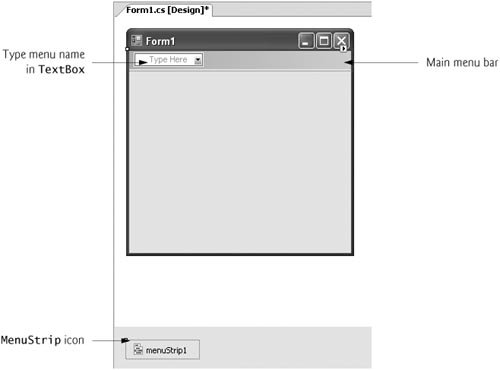
Figure 14.3. Adding ToolStripMenuItems to a MenuStrip.

To create an access shortcut (or keyboard shortcut), type an ampersand (&) before the character to be underlined. For example, to create the File menu item with the letter F underlined, type &File. To display an ampersand, type &&. To add other shortcut keys (e.g., -F9) for menu items, set the ShortcutKeys property of the appropriate ToolStripMenuItems. To do this, select the down arrow to the right of this property in the Properties window. In the window that appears (Fig. 14.4), use the CheckBoxes and dropdown list to select the shortcut keys. When you are finished, click elsewhere on the screen. You can hide the shortcut keys by setting property ShowShortcutKeys to false, and you can modify how the control keys are displayed in the menu item by modifying property ShortcutKeyDisplayString.
Figure 14.4. Setting a menu item's shortcut keys.
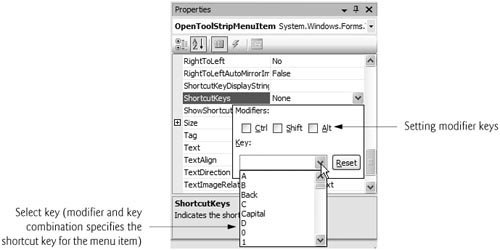
You can remove a menu item by selecting it with the mouse and pressing the Delete key. Menu items can be grouped logically by separator bars, which are inserted by right clicking the menu and selecting Insert Separator or by typing "-" for the text of a menu item.
In addition to text, Visual Studio allows you to easily add TextBoxes and ComboBoxes (drop-down lists) as menu items. When adding an item in Design mode, you may have noticed that before you enter text for a new item, you are provided with a drop-down list. Clicking the down arrow (Fig. 14.5) allows you to select the type of item to addMenuItem (of type ToolStripMenuItem, the default), ComboBox (of type ToolStripComboBox) and TextBox (of type ToolStripTextBox). We focus on ToolStripMenuItems. [Note: If you view this drop-down list for menu items that are not on the top level, a fourth option appears, allowing you to insert a separator bar.]
Figure 14.5. Menu item options.
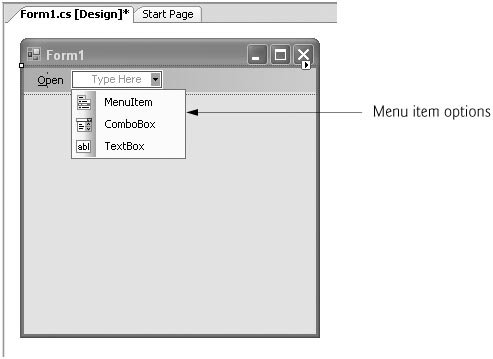
ToolStripMenuItems generate a Click event when selected. To create an empty Click event handler, double click the menu item in Design mode. Common actions in response to these events include displaying dialogs and setting properties. Common menu properties and a common event are summarized in Fig. 14.6.
|
MenuStrip and ToolStripMenuItem properties and an event |
Description |
|---|---|
|
MenuStrip Properties |
|
|
MenuItems |
Contains the top-level menu items for this MenuStrip. |
|
HasChildren |
Indicates whether MenuStrip has any child controls (menu items). |
|
RightToLeft |
Causes text to display from right to left. This is useful for languages that are read from right to left. |
|
ToolStripMenuItem Properties |
|
|
Checked |
Indicates whether a menu item is checked. The default value is false, meaning that the menu item is unchecked. |
|
CheckOnClick |
Indicates that a menu item should appear checked or unchecked as the item is clicked. |
|
Index |
Specifies an item's position in its parent menu. A value of 0 places the MenuItem at the beginning of the menu. |
|
MenuItems |
Lists the submenu items for a particular menu item. |
|
ShortcutKeyDisplayString |
Specifies text that should appear beside a menu item for a shortcut key. If left blank, the key names are displayed. Otherwise, the text in this property is displayed for the shortcut key. |
|
ShortcutKeys |
Specifies the shortcut key for the menu item (e.g., -F9 is equivalent to clicking a specific item). |
|
ShowShortcutKeys |
Indicates whether a shortcut key is shown beside menu item text. The default is true, which displays the shortcut key. |
|
Text |
Specifies the menu item's text. To create an Alt access shortcut, precede a character with & (e.g., &File to specify a menu named File with the letter F underlined). |
|
Common ToolStripMenuItem Event |
|
|
Click |
Generated when an item is clicked or a shortcut key is used. This is the default event when the menu is double clicked in the designer. |
|
Class MenuTestForm (Fig. 14.7) creates a simple menu on a Form. The Form has a top-level File menu with menu items About (which displays a MessageBox) and Exit (which terminates the program). The program also includes a Format menu, which contains menu items that change the format of the text on a Label. The Format menu has submenus Color and Font, which change the color and font of the text on a Label.
Figure 14.7. Menus for changing text font and color.
1 // Fig. 14.7: MenuTestForm.cs
2 // Using Menus to change font colors and styles.
3 using System;
4 using System.Drawing;
5 using System.Windows.Forms;
6
7 // our Form contains a Menu that changes the font color
8 // and style of the text displayed in Label
9 public partial class MenuTestForm : Form
10 {
11 // default constructor
12 public MenuTestForm()
13 {
14 InitializeComponent(); 15 } // end constructor 16 17 // display MessageBox when About ToolStripMenuItem is selected 18 private void aboutToolStripMenuItem_Click( object sender, EventArgs e ) 19 { 20 MessageBox.Show( 21 "This is an example
of using menus.", 22 "About", MessageBoxButtons.OK, MessageBoxIcon.Information ); 23 } // end method aboutToolStripMenuItem_Click 24 25 // exit program when Exit ToolStripMenuItem is selected 26 private void exitToolStripMenuItem_Click( object sender, EventArgs e ) 27 { 28 Application.Exit(); 29 } // end method exitToolStripMenuItem_Click 30 31 // reset checkmarks for Color ToolStripMenuItems 32 private void ClearColor() 33 { 34 // clear all checkmarks 35 blackToolStripMenuItem.Checked = false; 36 blueToolStripMenuItem.Checked = false; 37 redToolStripMenuItem.Checked = false; 38 greenToolStripMenuItem.Checked = false; 39 } // end method ClearColor 40 41 // update Menu state and color display black 42 private void blackToolStripMenuItem_Click( object sender, EventArgs e ) 43 { 44 // reset checkmarks for Color ToolStripMenuItems 45 ClearColor(); 46 47 // set Color to Black 48 displayLabel.ForeColor = Color.Black; 49 blackToolStripMenuItem.Checked = true; 50 } // end method blackToolStripMenuItem_Click 51 52 // update Menu state and color display blue 53 private void blueToolStripMenuItem_Click( object sender, EventArgs e ) 54 { 55 // reset checkmarks for Color ToolStripMenuItems 56 ClearColor(); 57 58 // set Color to Blue 59 displayLabel.ForeColor = Color.Blue; 60 blueToolStripMenuItem.Checked = true; 61 } // end method blueToolStripMenuItem_Click 62 63 // update Menu state and color display red 64 private void redToolStripMenuItem_Click( object sender, EventArgs e ) 65 {
66 // reset checkmarks for Color ToolStripMenuItems 67 ClearColor(); 68 69 // set Color to Red 70 displayLabel.ForeColor = Color.Red; 71 redToolStripMenuItem.Checked = true; 72 } // end method redToolStripMenuItem_Click 73 74 // update Menu state and color display green 75 private void greenToolStripMenuItem_Click( object sender, EventArgs e ) 76 { 77 // reset checkmarks for Color ToolStripMenuItems 78 ClearColor(); 79 80 // set Color to Green 81 displayLabel.ForeColor = Color.Green; 82 greenToolStripMenuItem.Checked = true; 83 } // end method greenToolStripMenuItem_Click 84 85 // reset checkmarks for Font ToolStripMenuItems 86 private void ClearFont() 87 { 88 // clear all checkmarks 89 timesToolStripMenuItem.Checked = false; 90 courierToolStripMenuItem.Checked = false; 91 comicToolStripMenuItem.Checked = false; 92 } // end method ClearFont 93 94 // update Menu state and set Font to Times New Roman 95 private void timesToolStripMenuItem_Click( object sender, EventArgs e ) 96 { 97 // reset checkmarks for Font ToolStripMenuItems 98 ClearFont(); 99 100 // set Times New Roman font 101 timesToolStripMenuItem.Checked = true; 102 displayLabel.Font = new Font( 103 "Times New Roman", 14, displayLabel.Font.Style ); 104 } // end method timesToolStripMenuItem_Click 105 106 // update Menu state and set Font to Courier 107 private void courierToolStripMenuItem_Click( 108 object sender, EventArgs e ) 109 { 110 // reset checkmarks for Font ToolStripMenuItems 111 ClearFont(); 112 113 // set Courier font 114 courierToolStripMenuItem.Checked = true; 115 displayLabel.Font = new Font( 116 "Courier", 14, displayLabel.Font.Style ); 117 } // end method courierToolStripMenuItem_Click
118 119 // update Menu state and set Font to Comic Sans MS 120 private void comicToolStripMenuItem_Click( object sender, EventArgs e ) 121 { 122 // reset checkmarks for Font ToolStripMenuItems 123 ClearFont(); 124 125 // set Comic Sans font 126 comicToolStripMenuItem.Checked = true; 127 displayLabel.Font = new Font( 128 "Comic Sans MS", 14, displayLabel.Font.Style ); 129 } // end method comicToolStripMenuItem_Click 130 131 // toggle checkmark and toggle bold style 132 private void boldToolStripMenuItem_Click( object sender, EventArgs e ) 133 { 134 // toggle checkmark 135 boldToolStripMenuItem.Checked = !boldToolStripMenuItem.Checked; 136 137 // use logical exlusive OR to toggle bold, keep all other styles 138 displayLabel.Font = new Font( 139 displayLabel.Font.FontFamily, 14, 140 displayLabel.Font.Style ^ FontStyle.Bold ); 141 } // end method boldToolStripMenuItem_Click 142 143 // toggle checkmark and toggle italic style 144 private void italicToolStripMenuItem_Click( 145 object sender, EventArgs e ) 146 { 147 // toggle checkmark 148 italicToolStripMenuItem.Checked = !italicToolStripMenuItem.Checked; 149 150 // use logical exclusive OR to toggle italic, keep all other styles 151 displayLabel.Font = new Font( 152 displayLabel.Font.FontFamily, 14, 153 displayLabel.Font.Style ^ FontStyle.Italic ); 154 } // end method italicToolStripMenuItem_Click 155 } // end class MenuTestForm
(a)
(b)
(c)
(d)
(e)
(f)
|
To create this GUI, begin by dragging the MenuStrip from the ToolBox onto the Form. Then use Design mode to create the menu structure shown in the sample outputs. The File menu (fileToolStripMenuItem) has menu items About (aboutToolStripMenuItem) and Exit (exitToolStripMenuItem); the Format menu (formatToolStripMenuItem) has two submenus. The first submenu, Color (colorToolStripMenuItem), contains menu items Black (blackToolStripMenuItem), Blue (blueToolStripMenuItem), Red (redToolStripMenuItem) and Green (greenToolStripMenuItem). The second submenu, Font (fontToolStripMenuItem), contains menu items Times New Roman (timesToolStripMenuItem), Courier (courierToolStripMenuItem), Comic Sans (comicToolStripMenuItem), a separator bar (dashToolStripMenuItem), Bold (boldToolStripMenuItem) and Italic (italicToolStripMenuItem).
The About menu item in the File menu displays a MessageBox when clicked (lines 1823). The Exit menu item closes the application through static method Exit of class Application (line 28). Class Application's static methods control program execution. Method Exit causes our application to terminate.
We made the items in the Color submenu (Black, Blue, Red and Green) mutually exclusivethe user can select only one at a time (we explain how we did this shortly). To indicate that a menu item is selected, we will set each Color menu item's Checked property to true. This causes a check to appear to the left of a menu item.
Each Color menu item has its own Click event handler. The method handler for color Black is blackToolStripMenuItem_Click (lines 4250). Similarly, the event handlers for colors Blue, Red and Green are blueToolStripMenuItem_Click (lines 5361), redToolStripMenuItem_Click (lines 6472) and greenToolStripMenuItem_Click (lines 7583), respectively. Each Color menu item must be mutually exclusive, so each event handler calls method ClearColor (lines 3239) before setting its corresponding Checked property to TRue. Method ClearColor sets the Checked property of each color MenuItem to false, effectively preventing more than one menu item from being selected at a time. In the designer, we initially set the Black menu item's Checked property to true, because at the start of the program, the text on the Form is black.
|
The Font menu contains three menu items for fonts (Courier, Times New Roman and Comic Sans) and two menu items for font styles (Bold and Italic). We added a separator bar between the font and font-style menu items to indicate that these are separate options. A Font object can specify only one font at a time but can set multiple styles at once (e.g., a font can be both bold and italic). We set the font menu items to display checks. As with the Color menu, we must enforce mutual exclusion of these items in our event handlers.
Event handlers for font menu items TimesRoman, Courier and ComicSans are timesToolStripMenuItem_Click (lines 95104), courierToolStripMenuItem_Click (lines 107117) and comicToolStripMenuItem_Click (lines 120129), respectively. These event handlers behave in a manner similar to that of the event handlers for the Color menu items. Each event handler clears the Checked properties for all font menu items by calling method ClearFont (lines 8692), then sets the Checked property of the menu item that raised the event to TRue. This enforces the mutual exclusion of the font menu items. In the designer, we initially set the Times New Roman menu item's Checked property to true, because this is the original font for the text on the Form. The event handlers for the Bold and Italic menu items (lines 132154) use the bitwise logical exclusive OR (^) operator to combine font styles, as we discussed in Chapter 13.
MonthCalendar Control |
Preface
Index
Introduction to Computers, the Internet and Visual C#
- Introduction
- What Is a Computer?
- Computer Organization
- Early Operating Systems
- Personal Computing, Distributed Computing and Client/Server Computing
- Hardware Trends
- Microsofts Windows® Operating System
- Machine Languages, Assembly Languages and High-Level Languages
- C#
- C, C++, Java and Visual Basic
- Other High-Level Languages
- The Internet and the World Wide Web
- Extensible Markup Language (XML)
- Microsofts .NET
- The .NET Framework and the Common Language Runtime
- Test-Driving a C# Application
- Software Engineering Case Study: Introduction to Object Technology and the UML
- Wrap-Up
- Web Resources
- Summary
- Terminology
- Self-Review Exercises
- Exercises
Introduction to the Visual C# 2005 Express Edition IDE
- Introduction
- Overview of the Visual Studio 2005 IDE
- Menu Bar and Toolbar
- Navigating the Visual Studio 2005 IDE
- Using Help
- Using Visual Programming to Create a Simple Program Displaying Text and an Image
- Wrap-Up
- Web Resources
- Summary
- Terminology
- Self-Review Exercises
- Exercises
Introduction to C# Applications
- Introduction
- A Simple C# Application: Displaying a Line of Text
- Creating Your Simple Application in Visual C# Express
- Modifying Your Simple C# Application
- Formatting Text with Console.Write and Console.WriteLine
- Another C# Application: Adding Integers
- Memory Concepts
- Arithmetic
- Decision Making: Equality and Relational Operators
- (Optional) Software Engineering Case Study: Examining the ATM Requirements Document
- Wrap-Up
- Summary
- Terminology
- Self-Review Exercises
- Exercises
Introduction to Classes and Objects
- Introduction
- Classes, Objects, Methods, Properties and Instance Variables
- Declaring a Class with a Method and Instantiating an Object of a Class
- Declaring a Method with a Parameter
- Instance Variables and Properties
- UML Class Diagram with a Property
- Software Engineering with Properties and set and get Accessors
- Value Types vs. Reference Types
- Initializing Objects with Constructors
- Floating-Point Numbers and Type decimal
- (Optional) Software Engineering Case Study: Identifying the Classes in the ATM Requirements Document
- Wrap-Up
- Summary
- Terminology
- Self-Review Exercises
- Exercises
Control Statements: Part 1
- Introduction
- Algorithms
- Pseudocode
- Control Structures
- if Single-Selection Statement
- if...else Double-Selection Statement
- while Repetition Statement
- Formulating Algorithms: Counter-Controlled Repetition
- Formulating Algorithms: Sentinel-Controlled Repetition
- Formulating Algorithms: Nested Control Statements
- Compound Assignment Operators
- Increment and Decrement Operators
- Simple Types
- (Optional) Software Engineering Case Study: Identifying Class Attributes in the ATM System
- Wrap-Up
- Summary
- Terminology
- Self-Review Exercises
- Exercises
Control Statements: Part 2
- Introduction
- Essentials of Counter-Controlled Repetition
- for Repetition Statement
- Examples Using the for Statement
- do...while Repetition Statement
- switch Multiple-Selection Statement
- break and continue Statements
- Logical Operators
- Structured Programming Summary
- (Optional) Software Engineering Case Study: Identifying Objects States and Activities in the ATM System
- Wrap-Up
- Summary
- Terminology
- Self-Review Exercises
- Exercises
Methods: A Deeper Look
- Introduction
- Packaging Code in C#
- static Methods, static Variables and Class Math
- Declaring Methods with Multiple Parameters
- Notes on Declaring and Using Methods
- Method Call Stack and Activation Records
- Argument Promotion and Casting
- The Framework Class Library
- Case Study: Random-Number Generation
- Case Study: A Game of Chance (Introducing Enumerations)
- Scope of Declarations
- Method Overloading
- Recursion
- Passing Arguments: Pass-by-Value vs. Pass-by-Reference
- (Optional) Software Engineering Case Study: Identifying Class Operations in the ATM System
- Wrap-Up
- Summary
- Terminology
- Self-Review Exercises
- Exercises
Arrays
- Introduction
- Arrays
- Declaring and Creating Arrays
- Examples Using Arrays
- Case Study: Card Shuffling and Dealing Simulation
- foreach Statement
- Passing Arrays and Array Elements to Methods
- Passing Arrays by Value and by Reference
- Case Study: Class GradeBook Using an Array to Store Grades
- Multidimensional Arrays
- Case Study: Class GradeBook Using a Rectangular Array
- Variable-Length Argument Lists
- Using Command-Line Arguments
- (Optional) Software Engineering Case Study: Collaboration Among Objects in the ATM System
- Wrap-Up
- Summary
- Terminology
- Self-Review Exercises
- Exercises
- Special Section: Building Your Own Computer
Classes and Objects: A Deeper Look
- Introduction
- Time Class Case Study
- Controlling Access to Members
- Referring to the Current Objects Members with the this Reference
- Indexers
- Time Class Case Study: Overloaded Constructors
- Default and Parameterless Constructors
- Composition
- Garbage Collection and Destructors
- static Class Members
- readonly Instance Variables
- Software Reusability
- Data Abstraction and Encapsulation
- Time Class Case Study: Creating Class Libraries
- internal Access
- Class View and Object Browser
- (Optional) Software Engineering Case Study: Starting to Program the Classes of the ATM System
- Wrap-Up
- Summary
- Terminology
- Self-Review Exercises
- Exercises
Object-Oriented Programming: Inheritance
- Introduction
- Base Classes and Derived Classes
- protected Members
- Relationship between Base Classes and Derived Classes
- Constructors in Derived Classes
- Software Engineering with Inheritance
- Class object
- Wrap-Up
- Summary
- Terminology
- Self-Review Exercises
- Exercises
Polymorphism, Interfaces & Operator Overloading
- Introduction
- Polymorphism Examples
- Demonstrating Polymorphic Behavior
- Abstract Classes and Methods
- Case Study: Payroll System Using Polymorphism
- sealed Methods and Classes
- Case Study: Creating and Using Interfaces
- Operator Overloading
- (Optional) Software Engineering Case Study: Incorporating Inheritance and Polymorphism into the ATM System
- Wrap-Up
- Summary
- Terminology
- Self-Review Exercises
- Exercises
Exception Handling
- Introduction
- Exception Handling Overview
- Example: Divide by Zero Without Exception Handling
- Example: Handling DivideByZeroExceptions and FormatExceptions
- .NET Exception Hierarchy
- finally Block
- Exception Properties
- User-Defined Exception Classes
- Wrap-Up
- Summary
- Terminology
- Self-Review Exercises
- Exercises
Graphical User Interface Concepts: Part 1
- Introduction
- Windows Forms
- Event Handling
- Control Properties and Layout
- Labels, TextBoxes and Buttons
- GroupBoxes and Panels
- CheckBoxes and RadioButtons
- PictureBoxes
- ToolTips
- NumericUpDown Control
- Mouse-Event Handling
- Keyboard-Event Handling
- Wrap-Up
- Summary
- Terminology
- Self-Review Exercises
- Answers To Self-Review Exercises
- Exercises
Graphical User Interface Concepts: Part 2
- Introduction
- Menus
- MonthCalendar Control
- DateTimePicker Control
- LinkLabel Control
- ListBox Control
- CheckedListBox Control
- ComboBox Control
- TreeView Control
- ListView Control
- TabControl Control
- Multiple Document Interface (MDI) Windows
- Visual Inheritance
- User-Defined Controls
- Wrap-Up
- Summary
- Terminology
- Self-Review Exercises
- Exercises
Multithreading
- Introduction
- Thread States: Life Cycle of a Thread
- Thread Priorities and Thread Scheduling
- Creating and Executing Threads
- Thread Synchronization and Class Monitor
- Producer/Consumer Relationship without Thread Synchronization
- Producer/Consumer Relationship with Thread Synchronization
- Producer/Consumer Relationship: Circular Buffer
- Multithreading with GUIs
- Wrap-Up
- Summary
- Terminology
- Self-Review Exercises
- Exercises
Strings, Characters and Regular Expressions
- Introduction
- Fundamentals of Characters and Strings
- string Constructors
- string Indexer, Length Property and CopyTo Method
- Comparing strings
- Locating Characters and Substrings in strings
- Extracting Substrings from strings
- Concatenating strings
- Miscellaneous string Methods
- Class StringBuilder
- Length and Capacity Properties, EnsureCapacity Method and Indexer of Class StringBuilder
- Append and AppendFormat Methods of Class StringBuilder
- Insert, Remove and Replace Methods of Class StringBuilder
- Char Methods
- Card Shuffling and Dealing Simulation
- Regular Expressions and Class Regex
- Wrap-Up
- Summary
- Terminology
- Self-Review Exercises
- Exercises
Graphics and Multimedia
- Introduction
- Drawing Classes and the Coordinate System
- Graphics Contexts and Graphics Objects
- Color Control
- Font Control
- Drawing Lines, Rectangles and Ovals
- Drawing Arcs
- Drawing Polygons and Polylines
- Advanced Graphics Capabilities
- Introduction to Multimedia
- Loading, Displaying and Scaling Images
- Animating a Series of Images
- Windows Media Player
- Microsoft Agent
- Wrap-Up
- Summary
- Terminology
- Self-Review Exercises
- Exercises
Files and Streams
- Introduction
- Data Hierarchy
- Files and Streams
- Classes File and Directory
- Creating a Sequential-Access Text File
- Reading Data from a Sequential-Access Text File
- Serialization
- Creating a Sequential-Access File Using Object Serialization
- Reading and Deserializing Data from a Sequential-Access Text File
- Wrap-Up
- Summary
- Terminology
- Self-Review Exercises
- Exercises
Extensible Markup Language (XML)
- Introduction
- XML Basics
- Structuring Data
- XML Namespaces
- Document Type Definitions (DTDs)
- W3C XML Schema Documents
- (Optional) Extensible Stylesheet Language and XSL Transformations
- (Optional) Document Object Model (DOM)
- (Optional) Schema Validation with Class XmlReader
- (Optional) XSLT with Class XslCompiledTransform
- Wrap-Up
- Web Resources
- Summary
- Terminology
- Self-Review Exercises
- Exercises
Database, SQL and ADO.NET
- Introduction
- Relational Databases
- Relational Database Overview: Books Database
- SQL
- ADO.NET Object Model
- Programming with ADO.NET: Extracting Information from a Database
- Querying the Books Database
- Programming with ADO.NET: Address Book Case Study
- Using a DataSet to Read and Write XML
- Wrap-Up
- Web Resources
- Summary
- Terminology
- Self-Review Exercises
- Exercises
ASP.NET 2.0, Web Forms and Web Controls
- Introduction
- Simple HTTP Transactions
- Multitier Application Architecture
- Creating and Running a Simple Web-Form Example
- Web Controls
- Session Tracking
- Case Study: Connecting to a Database in ASP.NET
- Case Study: Secure Books Database Application
- Wrap-Up
- Web Resources
- Summary
- Terminology
- Self-Review Exercises
- Exercises
Web Services
- Introduction
- .NET Web Services Basics
- Simple Object Access Protocol (SOAP)
- Publishing and Consuming Web Services
- Session Tracking in Web Services
- Using Web Forms and Web Services
- User-Defined Types in Web Services
- Wrap-Up
- Web Resources
- Summary
- Terminology
- Self-Review Exercises
- Exercises
Networking: Streams-Based Sockets and Datagrams
- Introduction
- Connection-Oriented vs. Connectionless Communication
- Protocols for Transporting Data
- Establishing a Simple TCP Server (Using Stream Sockets)
- Establishing a Simple TCP Client (Using Stream Sockets)
- Client/Server Interaction with Stream-Socket Connections
- Connectionless Client/Server Interaction with Datagrams
- Client/Server Tic-Tac-Toe Using a Multithreaded Server
- WebBrowser Control
- .NET Remoting
- Wrap-Up
- Summary
- Terminology
- Self-Review Exercises
- Exercises
Searching and Sorting
- Introduction
- Searching Algorithms
- Sorting Algorithms
- Wrap-Up
- Summary
- Terminology
- Self-Review Exercises
- Exercises
Data Structures
- Introduction
- Simple-Type structs, Boxing and Unboxing
- Self-Referential Classes
- Linked Lists
- Stacks
- Queues
- Trees
- Wrap-Up
- Summary
- Terminology
- Self-Review Exercises
- Exercises
Generics
- Introduction
- Motivation for Generic Methods
- Generic Method Implementation
- Type Constraints
- Overloading Generic Methods
- Generic Classes
- Notes on Generics and Inheritance
- Wrap-Up
- Summary
- Terminology
- Self-Review Exercises
- Exercises
Collections
- Introduction
- Collections Overview
- Class Array and Enumerators
- Non-Generic Collections
- Generic Collections
- Synchronized Collections
- Wrap-Up
- Summary
- Terminology
- Self-Review Exercises
- Exercises
Appendix A. Operator Precedence Chart
Appendix B. Number Systems
- B.1. Introduction
- B.2. Abbreviating Binary Numbers as Octal and Hexadecimal Numbers
- B.3. Converting Octal and Hexadecimal Numbers to Binary Numbers
- B.4. Converting from Binary, Octal or Hexadecimal to Decimal
- B.5. Converting from Decimal to Binary, Octal or Hexadecimal
- B.6. Negative Binary Numbers: Twos Complement Notation
- Summary
- Terminology
- Self-Review Exercises
- Exercises
Appendix C. Using the Visual Studio 2005 Debugger
- C.1. Introduction
- C.2. Breakpoints and the Continue Command
- C.3. The Locals and Watch Windows
- C.4. Controlling Execution Using the Step Into, Step Over, Step Out and Continue Commands
- C.5. Other Features
- C.6. Wrap-Up
- Summary
- Terminology
- Self-Review Exercises
Appendix D. ASCII Character Set
Appendix E. Unicode®
- E.1. Introduction
- E.2. Unicode Transformation Formats
- E.3. Characters and Glyphs
- E.4. Advantages/Disadvantages of Unicode
- E.5. Using Unicode
- E.6. Character Ranges
- Summary
- Terminology
- Self-Review Exercises
- Answers to Self-Review exercises
- Exercises
Appendix F. Introduction to XHTML: Part 1
- F.1. Introduction
- F.2. Editing XHTML
- F.3. First XHTML Example
- F.4. W3C XHTML Validation Service
- F.5. Headers
- F.6. Linking
- F.7. Images
- F.8. Special Characters and More Line Breaks
- F.9. Unordered Lists
- F.10. Nested and Ordered Lists
- F.11. Web Resources
Appendix G. Introduction to XHTML: Part 2
- G.1. Introduction
- G.2. Basic XHTML Tables
- G.3. Intermediate XHTML Tables and Formatting
- G.4. Basic XHTML Forms
- G.5. More Complex XHTML Forms
- G.6. Internal Linking
- G.7. Creating and Using Image Maps
- G.8. meta Elements
- G.9. frameset Element
- G.10. Nested framesets
- G.11. Web Resources
Appendix H. HTML/XHTML Special Characters
Appendix I. HTML/XHTML Colors
Appendix J. ATM Case Study Code
- Appendix J. ATM Case Study Code
- J.1. ATM Case Study Implementation
- J.2. Class ATM
- J.3. Class Screen
- J.4. Class Keypad
- J.5. Class CashDispenser
- J.6. Class DepositSlot
- J.7. Class Account
- J.8. Class BankDatabase
- J.9. Class Transaction
- J.10. Class BalanceInquiry
- J.11. Class Withdrawal
- J.12. Class Deposit
- J.13. Class ATMCaseStudy
- J.14. Wrap-Up
Appendix K. UML 2: Additional Diagram Types
Appendix L. Simple Types
Index
EAN: 2147483647
Pages: 600

